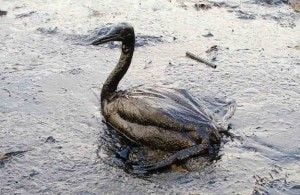An Oil Dispersant Made From Ingredients in Peanut Butter, Ice Cream and Chocolate?
New research is yielding oil dispersants that are non-toxic and prevent oil from sticking to birds and wildlife
/https://tf-cmsv2-smithsonianmag-media.s3.amazonaws.com/filer/20120820113047C-130_support_oil_spill_cleanup-small.jpg)
Two years ago, the explosion and subsequent oil spill from the Deepwater Horizon well in the Gulf of Mexico put oil dispersants in the news. In order to protect the Gulf coastline and minimize damage to oceanic ecosystems, dispersant chemicals were sprayed at the source of the leak—as well as on the floating sheet of oil on the water’s surface—to break up and dilute the harmful substance.
Many questioned the safety of the dispersants, however, and several of the ingredients in the chemicals deployed were shown to be toxic. Additionally, some scientists have argued that spreading oil throughout the water column, instead of leaving it concentrated on the surface, does more harm than good.
“The use of a traditional dispersant really comes down to the lesser of two evils,” says Lisa Kemp, a University of Southern Mississippi researcher who works on developing next-generation oil dispersant technologies. “Even if you have the safest possible dispersant, the components of the oil are toxic. So do you leave the oil on the surface of the water, where birds and other aquatic animals can be exposed to it, or do you add this dispersant to break the oil into small drops and send it through the water?”
Someday soon, though, oil spill cleanup coordinators might not have to make this type of difficult decision. Research by Kemp and her colleagues is yielding dispersants that are entirely harmless—and, intriguingly, are actually made from ingredients found in some familiar foods. ”Each of the ingredients in our dispersant is used in common food products like peanut butter, chocolate and whipped cream,” says Kemp, describing research she is presenting today at the American Chemical Society national meeting in Philadelphia. ”Other scientists are working on new oil dispersants and absorbents but nothing that’s quite like ours.”
Her research team’s new dispersant has another huge advantage over traditional dispersants: It’s extremely buoyant. The conventional approach is to break up an oil slick into tiny droplets that sink underneath the surface, so they improve the cosmetic appearance of the spill, but that puts new portions of the local ecosystem at risk. The new type of dispersant breaks up the slick into droplets that stay afloat, so they are made more available for oceanic microbes to digest and can also be more easily cleaned up by mechanical means such as boats with skimmers and absorbent booms.

Additionally, the new dispersant includes special non-stick polymers, so it is more effective than conventional formulas at protecting wildlife in the event of a spill. “It not only breaks up oil but prevents the deposition of oil on birds and other objects,” she explains. “Birds can sit in slicks of the dispersed oil, they can dive through it and take off and flap their wings, and the oil will fall off.”
Normally, removing oil from birds after a spill requires the use of detergents, which can remove their feathers’ natural waterproof coating. This leaves them less buoyant and more at risk of contracting hypothermia. Left to their own devices, birds often try to eat the oil on their feathers, leading to internal damage. The fact that the new dispersant prevents oil from sticking could be a huge boon for seabirds.
In order to develop the innovative dispersant, Kemp and her colleague, Robert Lochhead, looked to decades-old concepts from an unlikely source: the laundry detergent industry. Their polymer that coats the oil droplets and prevents them from sticking to birds, for instance, is inspired by a common ingredient in laundry detergent that prevents oil removed from a piece of clothing from getting re-depositing on other items in the wash. “Detergents include anti-redeposition agents that stick to oil and grease droplets removed by washing and keep them suspended in the water,” Kemp says.
After successfully testing their dispersant in the lab, Kemp and her team are looking to proceed to field trials of the substance on a larger scale. Although no one wants to see another maritime significant maritime oil spill, if the new dispersant proves successful, we may at least have a safer option for cleaning it up.
/https://tf-cmsv2-smithsonianmag-media.s3.amazonaws.com/accounts/headshot/joseph-stromberg-240.jpg)
/https://tf-cmsv2-smithsonianmag-media.s3.amazonaws.com/accounts/headshot/joseph-stromberg-240.jpg)